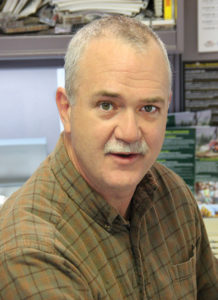Oregon Facing Danger Signs
Article by Dan Shell, Senior Editor, Timber Processing April 2024
 The state may be the top U.S. lumber producer right now, but log supply in Oregon the past 30 years or so has been an uneasy balance of private, federal (Forest Service and Bureau of Land Management) and state timberlands. Now, with state and private timber owners taking a regulatory harvest reduction, it’s more important than ever for federal officials to meet—and ideally increase—timber harvest levels to help maintain that balance.
The state may be the top U.S. lumber producer right now, but log supply in Oregon the past 30 years or so has been an uneasy balance of private, federal (Forest Service and Bureau of Land Management) and state timberlands. Now, with state and private timber owners taking a regulatory harvest reduction, it’s more important than ever for federal officials to meet—and ideally increase—timber harvest levels to help maintain that balance.
Officials with the American Forest Resource Council (AFRC) are sounding the alarm after three mill closures announced in Oregon this year: Hampton Lumber’s Banks mill, Interfor’s Philomath mill, and a two-year sawmill closure announced by Rosboro in Springfield while a new glulam plant is being constructed. In all three cases, the companies involved cited ongoing uncertainty over log supply as contributing to the closure decisions.
Also adding to raw material concerns is the ongoing impact of Oregon’s September 2020 wildfires that burned 971,000 acres of timberland and destroyed 15 billion BF of green timber with more than $30 billion in end-product value, according to an Oregon Forest Resources Institute report.
AFRC President Travis Joseph and organization members are urging the Pacific Northwest congressional delegation to take steps to help reverse the trend of more mill closures. This includes more active oversight to ensure the FS and BLM meet and increase timber harvest goals.
Maintaining a healthy and robust forest industry sector is also a key component of addressing federal forest health and wildfire issues. An additional $6 billion outlay to the FS and BLM to increase the pace and scope of forest treatments and stewardship projects hasn’t yielded an uptick in log supply that traditionally accompanies such projects, Joseph says, noting that the BLM’s western Oregon timber sale program this year has been arbitrarily reduced by more than 25%.
The group is also taking the long view on the issue of maintaining a vibrant forest industry sector. The cautionary tale is Arizona, where years of federal forest management neglect allowed forest industry infrastructure to almost disappear. And now, the state is still struggling to develop the timber processing and utilization facilities to make a difference in forest health operations.
There’s also the role of wood building materials and other wood products that sequester carbon permanently and help decarbonization efforts. It’s a sustainable industry that produces sustainable products.
Joseph adds: “If the Federal Government is going to be successful in addressing the current federal forest health and wildfire crises – and protect the extraordinary social, environmental, economic, and cultural values of our public lands – it must sustain and grow the forest infrastructure and related workforces.”
Latest News
Aging Like A Fine. . .Sawmill?
Article by Jessica Johnson, Senior Editor, Timber Processing April 2023 –Often I wonder what the future holds. I close my eyes and try to think 10, 15, 20 years down the line—30 years seems like a lifetime. Right now, in this moment, I’m a young mom, with young kids. I am in…
Vaagen Thanks Support For Midway Sawmill
The outpouring of support for Vaagen Fibre Canada’s Midway, BC sawmill, upon the early January Vaagen family announcement of the mill’s impending closure, was substantial, but apparently hasn’t changed the disappointing outcome, at least for now. The Vaagen family, whose Vaagen Brothers Lumber headquarters and sawmill is in Colville, Wash., announced on…
Mercer Gains Mass Timber Contract
Mercer International Inc. reported it has signed its first major mass timber project contract with a large consumer products retailer. The project, which is composed of cross-laminated timber panels, glue-laminated beams and connector elements, is expected to utilize four months of capacity at Mercer’s Spokane, Wash. facility on a one-shift basis over the course of 2023…
U.S. Housing Starts Rebound In February
U.S. housing starts brushed off a sluggish January and reached a seasonally adjusted rate of 1.45 million in February, up 9.8% over January. Single-family starts were 830,000, a percent above January, while multi-family (five units or more) were at 608,000, up a whopping 24% over January. The uptick in February broke a four-consecutive monthly decline for the combined starts…
Cooper Machine Partners With EWD
Cooper Machine Co., a long-established manufacturer of quality sawmill equipment located in Wadley, Ga., announced that it is partnering with German-based sawmill machine manufacturer EWD Sagetechnik. Cooper Machine has been offering equipment for sawmill, pallet, and post and pole mills since 1965. The company is in its third generation of successful management…
Find Us On Social
Newsletter
The monthly Timber Processing Industry Newsletter reaches over 4,000 mill owners and supervisors.
Subscribe/Renew
Timber Processing is delivered 10 times per year to subscribers who represent sawmill ownership, management and supervisory personnel and corporate executives. Subscriptions are FREE to qualified individuals.
Advertise
Complete the online form so we can direct you to the appropriate Sales Representative.
